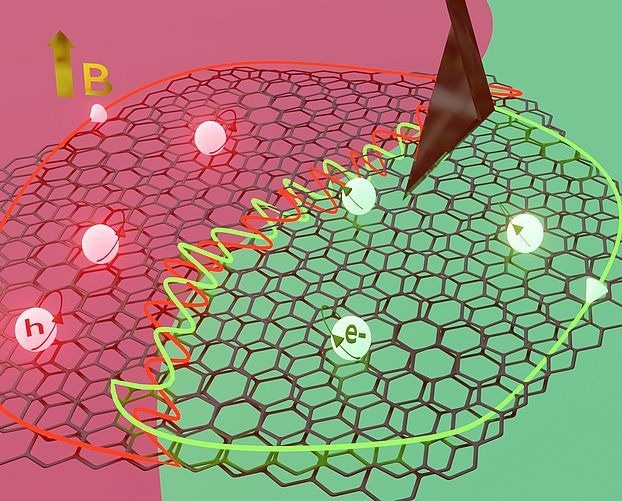An atomic force microscope operating in pendulum mode was utilized by SNI network researchers to examine a two-layer graphene device. The two pure carbon layers in this bilayer graphene were rotated by a “magic angle” of roughly 1.1° with respect to one another. The outcomes offer empirical evidence that the technique can be applied to adjust the device’s magnetization as well as current flow.
 The two graphene layers are twisted relative to one another by the magic angle of approximately 1.1°. Depending on how many electrons a single cell is filled with, the graphene exhibits different electrical and magnetic properties. Measurements can be made using the oscillating tip of an atomic force microscope. The green surface is doped with an excess of electrons, while the red surface is underdoped. Polarized circular currents are induced by the magnetic field. Image Credit: Department of Physics, University of Basel
The two graphene layers are twisted relative to one another by the magic angle of approximately 1.1°. Depending on how many electrons a single cell is filled with, the graphene exhibits different electrical and magnetic properties. Measurements can be made using the oscillating tip of an atomic force microscope. The green surface is doped with an excess of electrons, while the red surface is underdoped. Polarized circular currents are induced by the magnetic field. Image Credit: Department of Physics, University of Basel
The discoveries were recently published in the journal Communications Physics and were a component of a Ph.D. thesis supported by the Swiss Nanoscience Institute (SNI).
New technical possibilities, particularly in the area of quantum technology, are being made possible by recent advancements in the fabrication of devices made of 2D materials. However, energy losses in strongly interacting systems have not received much attention until now.
In light of this, a group under the direction of Professor Ernst Meyer of the University of Basel's Department of Physics employed an atomic force microscope operating in pendulum mode to thoroughly examine a graphene device. To do this, the researchers used a two-layer graphene that was created by LMU Munich colleagues and had two layers that were 1.08° twisted.
The two graphene layers create moiré superstructures when they are stacked and twisted in relation to one another, giving the material additional characteristics. For instance, graphene becomes a superconductor at extremely low temperatures, conducting electricity with nearly little energy loss, when the two layers are twisted by the so-called magic angle of 1.08°.
Fine-Tuning the Properties
Dr. Alexina Ollier has recently demonstrated that the twist angle of the atomic graphene layers was constant, at roughly 1.06°, across the layer by the use of atomic force microscopy (AFM) measurements. Additionally, she was able to measure how the charge given to the device can modify and adapt the graphene layer’s current-conducting capabilities.
The material exhibited an insulator or a semiconductor behavior, contingent upon the quantum of electrons that were added to each graphene cell. The researchers did not obtain superconductivity in the graphene because this phenomenon—current conduction without energy dissipation—only happens at a significantly lower temperature of 1.7 kelvins, which is higher than the comparatively high temperature of 5 kelvins (–268.15 °C) during the measurements.
We were able, however, not only to modify and measure the current-conducting properties of the device but also to impart magnetic properties to the graphene—which, of course, consists of nothing but carbon atoms.
Alexina Ollier, Ph.D. Student, Department of Physics, University of Basel
Professor Ernst Meyer from the Department of Physics at the University of Basel added, “It is an achievement that we are able to image tiny graphene flakes in electrical components, change their electrical and magnetic properties, and measure them precisely. In the future, this method will also help us to determine the energy loss of various two-dimensional components in the event of strong interactions.”
Journal Reference:
Ollier, A., et. al. (2023) Energy dissipation on magic angle twisted bilayer graphene. Communications Physics. doi:10.1038/s42005-023-01441-4